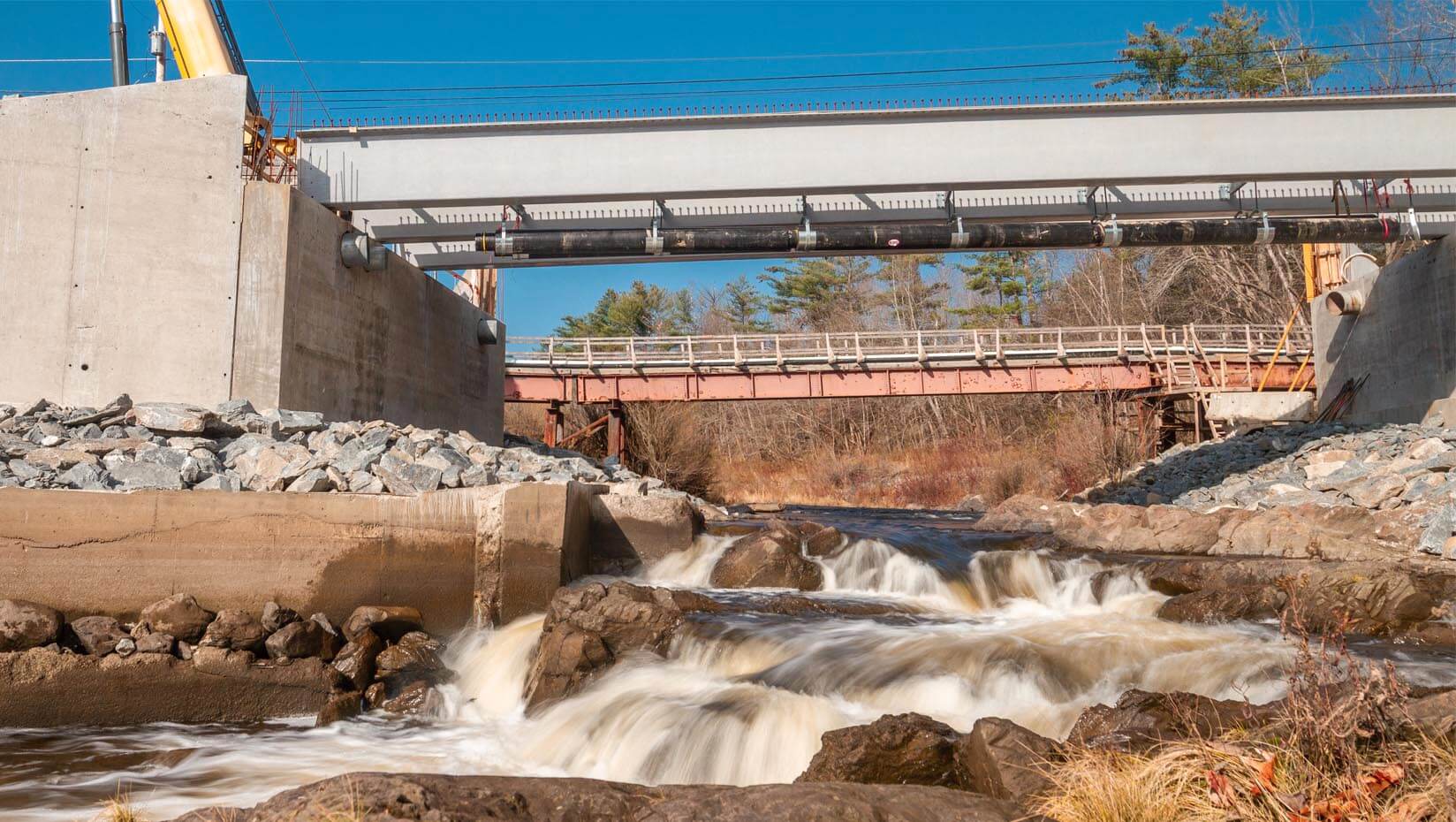
Hampden bridge event celebrates UMaine’s groundbreaking research in sustainable, low-cost transportation solutions
U.S. Sen. Susan Collins joined Maine Department of Transportation officials, University of Maine researchers, Advanced Infrastructure Technologies (AIT) Bridges and industry partners at the Grist Mill Bridge in Hampden, Maine on May 21 to celebrate the groundbreaking research that is leading the country toward a sustainable, low-cost transportation system of the future.
The 75-foot single-span Grist Mill Bridge carries traffic over the Souadabscook Stream. It is the first in the nation to use the fiber reinforced polymer (FRP) tub-girders called GBeams, designed and patented at the UMaine Advanced Structures and Composites Center and licensed to AIT Bridges.
Habib Dagher, executive director of the UMaine Composites Center, highlighted the GBeam technology during a recent hearing before the U.S. Senate Transportation Appropriations Subcommittee co-led by Collins.
“Grist Mill Bridge is the result of a great partnership between the University of Maine, AIT Bridges, and federal and state transportation departments. Working together, they have reached a milestone in advanced construction technology, while boosting economic growth and job creation here in Maine,” said Collins. “As ranking member of the Transportation Appropriations Subcommittee, my priority is to improve our nation’s infrastructure and ensure Maine’s needs are addressed. I was honored to invite Dr. Dagher to Washington last week to testify about how the Grist Mill Bridge design and other impressive examples of UMaine’s research and development can be utilized in infrastructure projects across the country.”
The patented GBeam technology results from research and development at the UMaine Composites Center, which licensed it to AIT Bridges, the university’s commercialization partner for this technology. Funding for the research was provided by the U.S. Army Corps of Engineers ERDC and the U.S. Department of Transportation through the Transportation Infrastructure Durability Center led by UMaine. The GBeams used in the Grist Mill Bridge project were manufactured at the AIT Bridges facility in Brewer, Maine.
The GBeam technology is corrosion resistant and designed to last over 100 years with little to no maintenance. The composite girders are lightweight, weighing as little as one-quarter the weight of steel girders. The GBeam technology is a promising, sustainable, low-cost alternative that is easy to install.
“The big draw here is durability,” said MaineDOT commissioner Bruce Van Note. “Time will not take quite the same toll on the composite tub girders in this bridge. We expect this structure will need less maintenance over time and may last 25 years longer than its conventional counterparts. At MaineDOT, we believe sponsoring this new technology now will yield long-term benefits for Maine taxpayers and travelers.”
The technology packs small, packs light, and can be deployed very quickly and easily, said Dagher. The girders are designed to be stackable, which reduces transportation costs and lowers their carbon footprint.
“One flatbed truck can transport enough girders for four 70-foot long bridges. That is four Grist Mill bridges on one stretch-bed,” Dagher said. And because they are lightweight, common rental cranes could be used during installation.
The practicability of the GBeam technology is further enhanced by the bolt system that connects the girders to the concrete deck, allowing the deck to be quickly removed for future replacement after 50 years without jackhammers. The ease of deck replacement will lower construction costs and minimize disruptive road closures.
The many benefits of the composite GBeam technology are attracting interest from Departments of Transportation across the U.S. The technology is already planned to be used in bridge replacement projects in Washington, California, Florida and Rhode Island. In Maine, the technology will also be used in the Hampden Twin Bridge project that will begin construction in 2022. Girders for these bridges will be fabricated by AIT and shipped to destinations nationwide.
“This is an example of a University of Maine research-to-commercialization initiative helping to address infrastructure needs statewide and nationwide while providing hands-on learning experiences for students and jobs in Maine,” said UMaine President Joan Ferrini-Mundy. “UMaine students at the Composites Center are members of tomorrow’s workforce, providing their own contributions today and leadership going forward. All of this is made possible with state investments in research and development, and vision and support of the Maine Congressional Delegation and legislators.”
“The R&D we are conducting at the Composites Center is delivering practical solutions to address our deteriorating infrastructure that is more durable, sustainable and cost-effective, and creating jobs right here in Maine,” said Dagher. “Thank you Sen. Collins, Commissioner Van Note, our partners at the U.S. Army Corps of Engineers, for your leadership in enabling this remarkable milestone. The Grist Mill bridge showcases the real-world applications resulting from cutting-edge research in composite materials.”
“AIT Bridges is honored to commemorate this inaugural GBeam bridge alongside the University of Maine, Sen. Susan Collins and MaineDOT,” said Brit Svoboda, chair and CEO of AIT. “The Grist Mill Bridge once again proves the viability and obligation to build more sustainable FRP composite bridges in Maine and the country. Adding the Composite GBeam Bridge System to the already successful GArch Composite Bridge System means AIT Bridges can provide a more comprehensive solution to the bridge industry.”
The University of Maine field-load-tested the Grist Mill Bridge with support from the MaineDOT and U.S. DOT. The bridge was successfully tested with more than 260,000 pounds of load carried by four MaineDOT trucks. The two-day testing provided baseline performance data allowing UMaine researchers and AIT Bridges to refine the GBeam design.
Contact: Meghan Collins, mc@maine.edu; 207.852.8414
